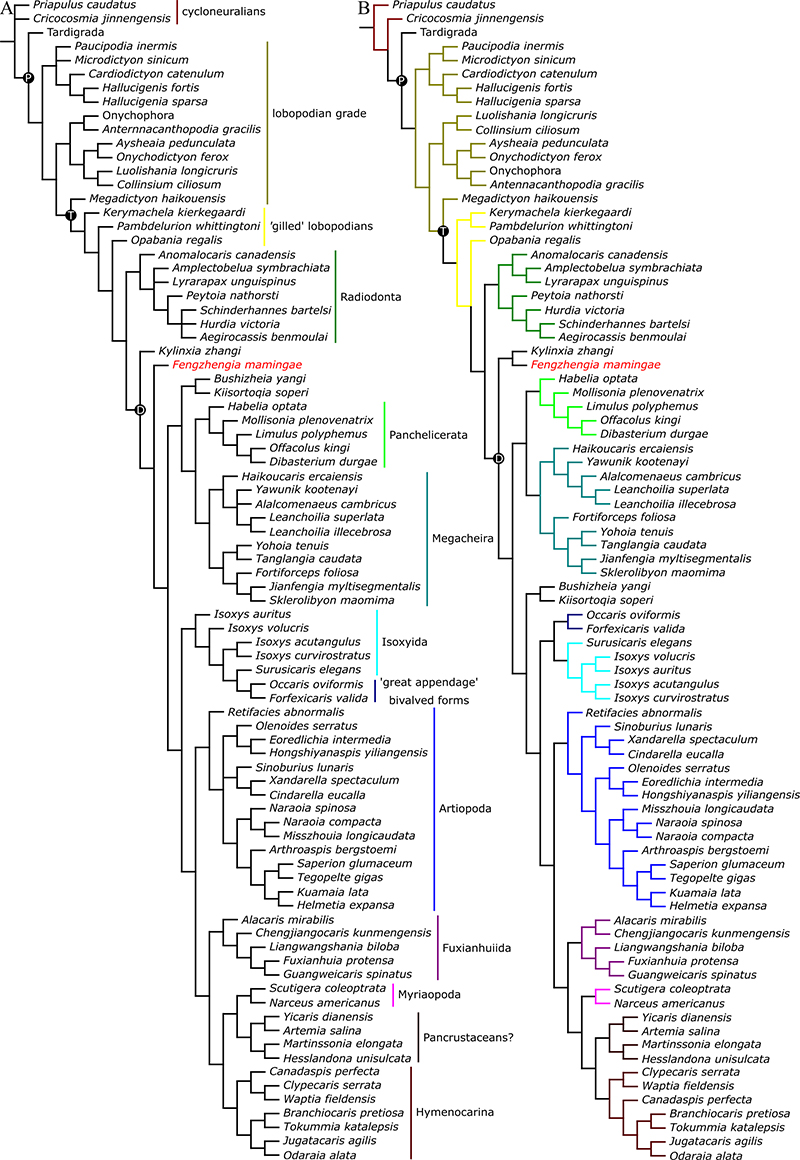FIGURE 1. Fengzhengia mamingae gen. et sp. nov. (YKLP 11431a). A-B, lateral view (stereo pair) of the part (stereo images have a tilt of 20˚ to emphasise topographic differences); C, composite line drawing of the same. All scale bars are 5 mm. Abbreviations: ist, indeterminate soft tissue; cw, compression wrinkle(s); en?, putative endopod podomere(s); es, eye stalk(s); ex?, putative exopod(s); gr, groove; hs, head shield; lae, left eye; ps?, putative pygidial segment; pyg?, putative pygidium; rae, right eye; tf, tail fan; tfm?, perceived margin of tail fan; t1-15, tergites 1 through 15.

FIGURE 2. Fengzhengia mamingae gen. et sp. nov. (YKLP 11431a). A, lateral view of the part; B-C, tomographic models of the part—lateral view of the part with the matrix partially removed digitally and lateral view of the part with the matrix further removed digitally, respectively. All scale bars are 5 mm. Blue and white arrowheads point to the tergopleurae of the third trunk segment and black and red arrowheads indicate the paddle shaped exopods of trunk limbs 1-3.

FIGURE 3. Fengzhengia mamingae gen. et sp. nov. (YKLP 11431a). A-C, tomographic models of the part. The specimen is orientated with the anterior facing left. All scale bars are 5 mm. The blue arrowheads point to the tergopleural terminus of the third trunk segment and, the red arrowheads indicate the paddle-shaped exopods of trunk limbs 1-3—transverse sections through flattened lobate exopods that clearly extend beyond the tergopleural termini, and white arrowheads indicate exopod setae. Abbreviations: 1, trunk exopod 1; 2, trunk exopod 2; 3, trunk exopod 3.

FIGURE 4. Fengzhengia mamingae gen. et sp. nov. (YKLP 11431b). A-B, lateral view (stereo pair) of the counterpart (stereo images have a tilt of 20˚ to emphasise topographic differences); C, composite line drawing of the same. All scale bars are 5 mm. Abbreviations: es, eye stalk(s); ex?, putative exopod(s); hl, frontal head limb; hs, head shield; lae, left eye; t8, tergite 8.

FIGURE 5. Fengzhengia mamingae gen. et sp. nov. (YKLP 11431). A, part (boxed regions are shown in E-J); B, counterpart (boxed regions are shown in C-D); C, tungsten photography lighting of head region in B; E, posterior body region from A; G, trunk tergites from A; I, head region from A; D, F, H, J, fluorescent photography lighting of the same. Arrowheads indicate medial axial spines. Scale bars are 5 mm (A-B, I-J); 2 mm (C-H). Abbreviations: asc?, putative anterior sclerite; cw, compression wrinkle(s); ed, endite(s); en?, putative endopod; es, eye stalk(s); hs, head shield; lae, left eye; p1-p6, podomeres 1 through 6; ps?, putative pygidial segment(s); pyg?, putative pygidium; rae, right eye; rm, rim of eye; sh, shaft of frontal head limb; tf, tail fan; 't1, tergite 1; t7, tergite 7; t15, tergite 15.

FIGURE 6. Fengzhengia mamingae gen. et sp. nov. (YKLP 11431). A-B, tungsten photography and fluorescent photography lighting of putative pygidium and tail fan, respectively; C, interpretive line drawing of the same. All scale bars are 1 mm. Abbreviations: cw, compression wrinkles; en?, putative endopod podomeres; ex?, putative exopod(s); ps?, putative pygidial segment(s); pyg?, putative pygidium; tf, tail fan; tfm?, perceived margin of tail fan; t15, tergite 15.

FIGURE 7. Consensus trees from Bayesian (left) and parsimony (right) analyses of panarthropod relationships based on a matrix of 283 characters and 84 taxa with deutocerebral frontal-most appendages inferred. A, 50% majority-rule consensus tree from a Bayesian analysis; B, strict consensus of a single most parsimonious tree of 54.38597 steps (consistency index = 0.48; retention index = 0.86) from a parsimony analysis using implied character weighting (concavity constant k = 3). In the parsimony analysis Fengzhengia mamingae gen. et sp. nov. is retrieved as the sister taxon to the early branching deuteropod Kylinxia zhangi Zeng, Zhao, and Huang in Zeng et al., 2020. In the Bayesian analysis F. mamingae is resolved as a deuteropod that bridges between K. zhangi and all other deuteropods. Abbreviations: D, Deuteropoda; P, Panarthropoda; T, total-group Euarthropoda.

FIGURE 8. Diagrammatic reconstructions of Fengzhengia mamingae gen. et sp. nov. A, dorsal view; B, lateral view. The scale bar is 5 mm. Abbreviations: as, medial axial spines; en, endopod; ex, exopod; hl, frontal head limb; hs, head shield; lae, left eye; pyg?, putative pygidium; rae, right eye; tf, tail fan; t1, tergite 1; t9, tergite 9; t15, tergite 15. Morphological details of the tail fan were partially inferred from Kylinxia zhangi Zeng, Zhao, and Huang in Zeng et al., 2020.

FIGURE 9. Artistic reconstruction of Fengzhengia mamingae gen. et sp. nov.


